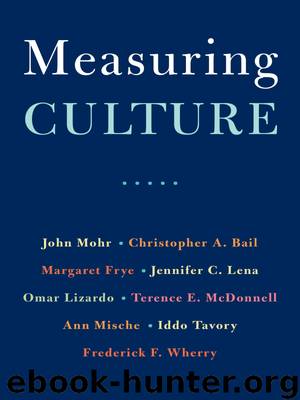Measuring Culture by John W. Mohr

Author:John W. Mohr
Language: eng
Format: epub
Tags: SOC026000, Social Science/Sociology/General, SOC026040, Social Science/Sociology/Social Theory
Publisher: Columbia University Press
Published: 2020-08-10T16:00:00+00:00
METHODOLOGICAL CHOICES AND CHALLENGES
Mapping Distributions of Types of Capital
For Bourdieu, measuring a field involves searching for the system of goods, or capital, that is specific to the field and for the social organization of how that capital is distributed and how it operates. He theorized that the forces that operated in every field were governed by one or more types of capital, or styles and stocks of resources that were accepted as given, and thus as providing the basis for legitimate power and position within the given social arena. Bourdieu distinguished among various kinds of capital—economic, cultural, and social—each of which he defined as a distinctive form of good. But he also highlighted that every field is grounded in its own specific type of capital, which together helps define the core set of practices and understandings that hold sway in the corresponding arenas of discourse and practice, and which ultimately constitutes what is at stake in a given field. Capital empowers its possessors because when one has an amount of field-specific capital, so too does one have the capacity to act with power and force within the field. According to Bourdieu, the inverse is also true; the more power one has within the field, the more capacity that one has to help shape and mold what counts as capital in that social arena.
How does Bourdieu’s work help us understand the measurement of culture within fields? In his empirical studies of different fields (e.g., higher education, law, and art), Bourdieu identified not only different forms of capital that operated within these fields, but also a general tendency for this capital to be unevenly distributed across a given field, thus reflecting (and creating) systems of inequality and forms of power. For example, in his study of French research universities, Bourdieu describes how the academic field was largely governed by the competing logics of two types of capital. First, he identifies a logic defined by acclaim in the field of science itself, within the highly contested and socially ordered social space of research.71 Second, he describes a logic ordered by the accumulation of economic capital that was necessary to sustain the university and the research endeavor itself. In his discussion of the field of law, Bourdieu identifies a variety of competing capitals, including the critical opposition between the capital associated with “the position of the ‘theorist’ dedicated to pure doctrinal construction against the position of the ‘practitioner’ concerned only with the realm of its application.”72
Two things are new here with regard to measurement. One is Bourdieu’s focus on treating a taste for specific cultural content as the object of formal analysis. Here, his methodological innovation was sometimes as simple as using survey and interview responses to look for orderings in taste preferences by occupational membership. So, for example, in the very first figure in his book Distinction, Bourdieu presents a set of three simple graphs showing how members of various occupational groupings (ranging from manual workers at one end to higher-education teachers and
Download
This site does not store any files on its server. We only index and link to content provided by other sites. Please contact the content providers to delete copyright contents if any and email us, we'll remove relevant links or contents immediately.
Nudge - Improving Decisions about Health, Wealth, and Happiness by Thaler Sunstein(6633)
iGen by Jean M. Twenge(4702)
The Fire Next Time by James Baldwin(4342)
Adulting by Kelly Williams Brown(3669)
The Sports Rules Book by Human Kinetics(3588)
The Hacking of the American Mind by Robert H. Lustig(3579)
The Ethical Slut by Janet W. Hardy(3502)
Captivate by Vanessa Van Edwards(3296)
Mummy Knew by Lisa James(3166)
In a Sunburned Country by Bill Bryson(2946)
Ants Among Elephants by Sujatha Gidla(2924)
The Worm at the Core by Sheldon Solomon(2917)
Suicide: A Study in Sociology by Emile Durkheim(2609)
The Slow Fix: Solve Problems, Work Smarter, and Live Better In a World Addicted to Speed by Carl Honore(2574)
Humans of New York by Brandon Stanton(2379)
Handbook of Forensic Sociology and Psychology by Stephen J. Morewitz & Mark L. Goldstein(2376)
Blackwell Companion to Sociology, The by Judith R. Blau(2318)
The Happy Hooker by Xaviera Hollander(2274)
Outliers by Malcolm Gladwell(2256)
